Home | Category: Religion and Gods
ANCIENT ROMAN RELIGION
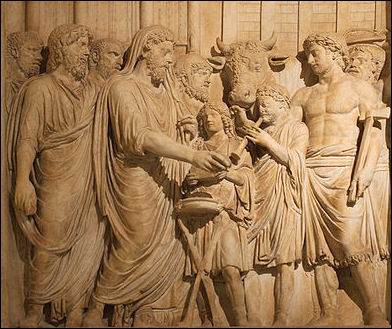
Bas relief from Arch of Marcus Aurelius
showing a sacrificeThe Roman had their traditional ceremonies and they worshiped Roman gods as well as gods from other provinces and city states. After Augustus, emperor worship was also incorporated into the Roman religion.
Dr Nigel Pollard of Swansea University wrote for the BBC: “Religious practices and beliefs within the Roman empire were diverse, and varied between regions and individuals. At their core, however, lay the state religion, which was the state-recognised and prescribed worship of traditional gods (like Jupiter and Mars), of the emperor (generally only when deceased), and of certain members of the imperial family ('the imperial cult'). This existed throughout the empire, but Roman religion was not exclusive. It co-existed with local pre-Roman cults, with empire-wide imported cults (eg Mithraism), and with individual superstitions and belief in magic. Roman authorities were tolerant of other religions if they didn't threaten public order or Roman control.”[Source: Dr Nigel Pollard of Swansea University, BBC, March 29, 2011 |::|]
J. A. S. Evans wrote in the New Catholic Encyclopedia: Religion was pervasive in Roman society. A visit to the remains of an ancient town like Pompeii makes us aware of it. At one end of the forum is the temple of Jupiter on its high podium, adjacent to west flank is the Temple of Apollo, and on the east side is the Temple of the Genius Augusti, the sanctuary of the imperial cult, which was built by the public priestess Mamia. Vitruvius recommends that a city should find an elevated site for the temple of the Divine Triad of Jupiter, Juno, and Minerva, a site in the forum or the market place for Mercury, Apollo, and Bacchus near the theater, Isis and Serapis in the market, Hercules at the gymnasium or amphitheater if the city has one, or otherwise at the circus, Mars and Venus outside the city, Mars at the trooping ground, and Venus by the harbor if the city is on the sea. In the houses of Pompeii we find small shrines to the Lares and the Penates, and the Genius of the household where the householder might make a small sacrifice of salted meal. Paganism was a religion of sacrifices, performed with rituals that adhered to rigid formulas and festivals that marked the yearly calendar.[Source: J. A. S. Evans, New Catholic Encyclopedia, Encyclopedia.com]
In “Decline and Fall of the Roman Empire” , the 18th-century historian Edward Gibbon, cynically observed: "The various modes of worship, which prevailed in the Roman world, were all considered by the people, as equally true; by the philosopher, as equally false; and by the magistrate, as equally useful. And thus toleration produced not only mutual indulgence, but even religious concord."
Websites on Ancient Rome: Internet Ancient History Sourcebook: Rome sourcebooks.fordham.edu ; Internet Ancient History Sourcebook: Late Antiquity sourcebooks.fordham.edu ; BBC Ancient Rome bbc.co.uk/history; Perseus Project - Tufts University; perseus.tufts.edu ; Lacus Curtius penelope.uchicago.edu; The Internet Classics Archive classics.mit.edu ; Bryn Mawr Classical Review bmcr.brynmawr.edu; Cambridge Classics External Gateway to Humanities Resources web.archive.org; Ancient Rome resources for students from the Courtenay Middle School Library web.archive.org ; History of ancient Rome OpenCourseWare from the University of Notre Dame web.archive.org ; United Nations of Roma Victrix (UNRV) History unrv.com
RECOMMENDED BOOKS:
“Religions of Rome: Volume 1: A History” by Mary Beard, John North, Simon Price ( Amazon.com;
“Religions of Rome: Volume 2: A Sourcebook” by Mary Beard, John North, Simon Price ( Amazon.com;
“Roman Religion” (Cambridge Introduction to Roman Civilization)
by Valerie M. Warrior (2006) Amazon.com;
“Religion in the Roman Empire” by James B. Rives Amazon.com;
“The Dancing Lares and the Serpent in the Garden: Religion at the Roman Street Corner” by Harriet I. Flower (2017) Amazon.com;
"Archaic Roman Religion, Volume 1 Paperback by Georges Dumézil, Philip Krapp (1996) Amazon.com;
“Archaic Roman Religion, Volume 2" by Georges Dumézil (1996) Amazon.com;
Roman Myths: Gods, Heroes, Villains and Legends of Ancient Rome” by Martin J Dougherty (2022) Amazon.com;
“The Oxford Dictionary of Classical Myth and Religion” by Simon Price and Emily Kearns (2003) Amazon.com;
“Greek and Roman Religions” (Blackwell) by Rebecca I. Denova Amazon.com;
“Greek Religion; Archaic and Classical Periods” by Walter Burkert (1985) Amazon.com;
“Miasma: Pollution and Purification in Early Greek Religion” by Robert Parker (1983) Amazon.com;
“Ancient Greek Religion: A Sourcebook” by Emily Kearns (2010) Amazon.com;
“Household Gods: Private Devotion in Ancient Greece and Rome” by Alexandra Sofroniew (2015) Amazon.com;
“Dawn of the Gods” by Jacquetta Hawkes (1968) Amazon.com
“Religions of the Hellenistic-Roman Age” by Antonia Tripolitis (2001) Amazon.com;
“The Religion of the Etruscans” by Nancy Thomson de Grummond, Erika Simon (2006) Amazon.com;
“Greek and Roman Animal Sacrifice: Ancient Victims, Modern Observers”
by Christopher A. Faraone and F. S. Naiden (2012) Amazon.com;
“Magic and Religion in the Ancient Mediterranean World” by Radcliffe G. Edmonds III and Carolina López-Ruiz (2023) Amazon.com
“The Divine Liver: The Art And Science Of Haruspicy As Practiced By The Etruscans And Romans” by Rev. Robert Lee Ellison (2013) Amazon.com;
“Pagans and Christians” by Robin Lane Fox (1986) Amazon.com
“Religion in Roman Egypt” by David Frankfurter (2000) Amazon.com;
Basic Concepts in Roman Religion
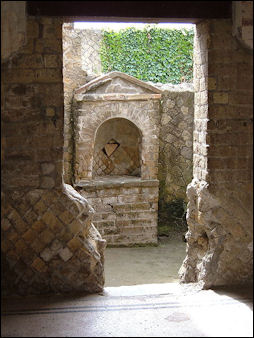
House altar in HerculaneumAccording to the Encyclopedia of Religion: The idea of obligation lies at the very root of the Romans' attitude toward the gods, and it is expressed in the word religio. Religio expresses a fundamental preoccupation manifested in two complementary ways: the care taken to avoid divine wrath, and the desire to win the benevolence and favor of the gods. It was the Romans' inner conviction that without the accord of the gods they could not succeed in their endeavors. This explains the solemn declaration of Cicero (106–43 B.C.) proclaiming the Roman people to be "the most religious in the world" (De natura deorum 2.3). This preoccupation is evident throughout the history of Livy (59 B.C.–17 ce). Roman accomplishments rise and fall in complete rhythm with the disfavor or favor evinced by the gods. [Source: Robert Schilling (1987), Jörg Rüpke (2005), Encyclopedia of Religion, Encyclopedia.com]
Ideas as religion were not reflected upon before the very end of the Republic. It was under the influence of Greek philosophy that some Roman authors (usually at the end of their political career) started to systematically reflect upon their own religious tradition in order to clarify concepts. Cicero is the foremost exponent, realizing in his books On the Nature of the Gods, On Divination, and On Fate a multivolume theological project. However, his reflections on religion did not arrive at a unified concept: religio was a feeling of obligation; pietas (piety), a corresponding attitude; and sacra (rituals) and caerimonia (forms of veneration), were the way to put religio and pietas into practice.
Because a general concept of religion as a system of actions and ideas was lacking, no corresponding concept of "sacred law" could exist. There were rules to be followed in matters of divine property, divination, and priests, but they did not add up to a ius sacrum, a phrase that did not exist in antiquity. And even these rules were flexible, matters of debate, traditions frequently fixed only under the impact of the encounter with Greek critical thought. The term Roman religion, therefore, encompasses what belongs to our modern concept of religion.
Practical, Public Side of Roman Religion
The Romans were regarded as practical people. It can be argued that they were more consumed with building, organizing and enjoying themselves and did not seem to concern themselves too much with spiritual and religious matters. In general, the Romans took a more light hearted view of spiritual matters and the gods they worshiped reflected this.
For Romans religion was more of a duty than it was for the Greeks. Cults, superstition, rituals, festivals and sacrifices appealed to them more than devotion and morality. The priesthood was often more interested in politics than spirituality. The Senate and Emperor were religious figures. However, exalted qualities, such as honor and virtue were valued and promoted. Alongside of the temple to Juno, for example, were temples for Loyalty and Hope.
L. Michael White of the University of Texas at Austin told PBS: “Religion in the Roman empire or what we tend to call paganism was really very much a public affair. It was a blend of belief in the old deities of the Greek and Roman pantheons. The kind of stories that are told in Greek mythology. Put together with civic pride, honor and duty. The very term liturgy comes from a Greek word that designates the duties, the obligations of the civic magistrates in observing the festival days of the city. One went and performed one's liturgies if you were the mayor of the city and that has both a public civil function and also a pious religious function. .... To be a citizen of the polis, the very word from which we get politics. To be a citizen of the city is to be a part of the economy of human life that extends from the earth into the heavens, thus in their view of the world there's an integral relationship between the gods worshipped in the temples down the street and the work of the civil magistrates in carrying out law and justice and civil welfare. [Source: L. Michael White, Professor of Classics and Director of the Religious Studies Program University of Texas at Austin, Frontline, PBS, April 1998 ]
Some scholars have suggested there was a decay of religion and morals after the Punic Wars (264 to 146 B.C.). While the Romans, during this period, showed many signs of progress in the areas of law, art, and literature, they was also evidence of stronger desires for luxury, entertainment, pleasure and display. This trend has been attributed to the influence of foreign superstitions and ceremonies and increased wealth and power brought about by conquest. It has been said that ambition and avarice corrupted the life of the Roman people. One remedy for this was found in the philosophy of the Greeks, which, however, appealed only to the educated classes. [Source: “Outlines of Roman History” by William C. Morey, Ph.D., D.C.L. New York, American Book Company (1901) \~]
Paganism

worship of the Egyptian god Issus in Pompeii
The Romans were call Pagans and their religion has been described as paganism, meaning the worship of more than one god. Paula Fredriksen of Boston University told PBS: “Paganism is our designation for what ninety-something percent of the people in the Mediterranean were doing. Jews are a visible minority, and then, everybody is doing lots of other things. Paganism is extremely various. It's local. It's energetic. It has all sorts of different layers. The gods appear to people routinely. People are in contact with their gods. [Source: Paula Fredriksen, William Goodwin Aurelio Professor of the Appreciation of Scripture, Boston University, Frontline, PBS, April 1998 ]
There's an interesting story in the Acts of the Apostles, where Paul and, I can't remember if it's Silas or Barnabus, work a cure in a town and the people who are witnessing him do this decide that it's Zeus and Hermes who have come to town. And the Priests start lugging out an animal to sacrifice and Paul says, "No, no, no, no, you don't ... let me tell you this." And then he starts. But that's an interesting measure of how common the expectation is that gods appear. Gods appear in dreams. People fall asleep every night. So there's a contact between heaven and Earth that's articulated in terms of traditional Roman and Greek culture.
“If you were a pagan person living in the first century, you would have, first of all, the gods of your own family, who[m] you would be responsible to. Some kind of ancestor worship, or perhaps if you were an aristocratic Roman, Venus or one of the other gods might be, as with Julius Caesar's family, might be one of the founding ancestors of your particular household. You would have the gods of the city, itself. And it's those city gods, in combination with the gods of the Empire, that would structure time for you. Because it's the city gods and the civic holidays that give you your days off. Five day holidays that are the feast of this or the feast of that. Literally, when everybody stops working and rich patrons of the city would pay for banquets.
“There's all sorts of religions. It's incredibly rich. It's not unlike twentieth century America. You have low-tech religions, like magic. People routinely go to magicians. If you have a sinus infection. If you need somebody to fall in love with you. If you're betting on a horse and you've lost the past three races, you go to a professional. We have magic books that are books of recipes, and they're indexed and you can look up what you need, and the professional will help you. By the way, Jews and also Christians, enter into this magical inheritance, too....
“It's a spiritual universe that's thickly populated with gods and spirits. When you look up into the stars at night, you see thousands of heroes and ... and maybe where your soul will go if you know how to slip the coil and go back through the planetary spheres, and go up. Paganism is the rich native religious stew of traditional society in the Mediterranean. And centuries after even the conversion of Constantine, we find endowments to liturgies, to mystery cults, to different Egyptian and Greco-Roman gods. Paganism continues on even after the conversion to Christianity.”
Case for Polytheism
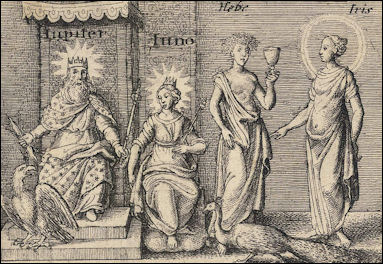
Jupiter and his wives
by Wenceslas Hollar The Romans and Greeks practiced polytheism: the worship of many gods. Polytheists have traditionally been looked down upon by practitioners of the great monotheistic religion which worship only a single god — Judaism, Christianity, Islam — as primitive and barbaric pagans. But who knows maybe they had it right.
Mary Leftowitz, a classics professor at Wellesley College, argues that a lot of world’s troubles today can be blamed in monotheism. In the Los Angeles Times she wrote, “The polytheistic Greeks didn’t advocate killing those who worshiped a different gods, and they did not pretend that their religion provided all the right answers. Their religion made the ancient Greeks aware of their ignorance and weakness, letting them recognize multiple points of view. ..It suggests that collective decisions often lead to better outcomes. Respect for a diversity of viewpoints informs the cooperative system the Athenians called democracy.”
“Unlike the monotheistic traditions Greco-Roman polytheism was multicultural...The world, as the Greek philosopher Thales wrote, is full of gods, and all deserve respect and honor. Such a generous understanding of nature called the ancient Greeks and Romans to accept and respect other people’s gods and to admire (rather than despise) other nations for their own notions of piety. If the Greeks were in close contact with a particular nation they gave their foreign gods names of their own gods: The Egyptian goddess Isis was Demeter; Horus was Apollo and so on.”
Roman and Carthaginian Religions Compared

Carthage Temple
Polybius (c.200-after 118 B.C.) wrote in “History” Book 6: “But among all the useful institutions, that demonstrate the superior excellence of the Roman government, the most considerable perhaps is the opinion which the people are taught to hold concerning the gods: and that, which other men regard as an object of disgrace, appears in my judgment to be the very thing by which this republic chiefly is sustained. I mean, superstition: which is impressed with all it terrors; and influences both the private actions of the citizens, and the public administration also of the state, in a degree that can scarcely be exceeded. [Source: Polybius (c.200-after 118 B.C.), Rome at the End of the Punic Wars, “History” Book 6. From: Oliver J. Thatcher, ed., “The Library of Original Sources” (Milwaukee: University Research Extension Co., 1907), Vol. III: The Roman World, pp. 166-193]
“This may appear astonishing to many. To me it is evident, that this contrivance was at first adopted for the sake of the multitude. For if it were possible that a state could be composed of wise men only, there would be no need, perhaps, of any such invention. But as the people universally are fickle and inconstant, filled with irregular desires, too precipitate in their passions, and prone to violence; there is no way left to restrain them, but by the dread of things unseen, and by the pageantry of terrifying fiction. The ancients, therefore, acted not absurdedly, nor without good reason, when they inculcated the notions concerning the gods, and the belief of infernal punishments; but much more those of the present age are to be charged with rashness and absurdity, in endeavoring to extirpate these opinions.
“For, not to mention effects that flow from such an institution, if, among the Greeks, for example, a single talent only be entrusted to those who have the management of any of the public money; though they give ten written sureties, with as many seals and twice as many witnesses, they are unable to discharge the trusts reposed in them with integrity. But the Romans, on the other hand, who in the course of their magistracies, and in embassies, disperse the greatest sums, are prevailed on by the single obligation of an oath to perform their duties with inviolable honesty. And as, in other states, a man is rarely found whose hands are pure from public robbery; so, among the Romans, it is no less rare to discover one that is tainted with this crime. But all things are subject to decay and change. This is a truth so evident, and so demonstrated by the perpetual and the necessary force of nature, that it needs no other proof.”
Foreign Influences on Roman Religion

temple for the Egyptian goddess Isis in Pompeii
As Rome came into contact with other people, its religion was affected by foreign influences. The worship of the family remained much the same; but the religion of the state became considerably changed. Even some of the superstitious and rites from Asia found their way into Rome. By absorbing ideas of other peoples, Roman religion became a broad-based, composite form of paganism. [Source: “Outlines of Roman History” by William C. Morey, Ph.D., D.C.L. New York, American Book Company (1901) \~]
Harold Whetstone Johnston wrote in “The Private Life of the Romans”: “The religion of the Romans was originally a simple animism, that is, a belief in spirits or powers (numina) associated with all things about man and with all man’s acts. These spirits were not personified and were not conceived of as human in form. There were no temples and no statues of gods. Rites were clean and simple, performed with a scrupulous exactness felt as pleasing to the gods, who were friendly when thus worshiped. It was the religion of a simple agricultural people. Study of the calendars that have come down to us shows that the older festivals that kept their places in such calendars were marked by larger letters. These were rural festivals, marking the year of the country people. [Source: “The Private Life of the Romans” by Harold Whetstone Johnston, Revised by Mary Johnston, Scott, Foresman and Company (1903, 1932) |+|]
“But as the Romans came in contact with other peoples and their religions, and as they developed from a small Italian community to an imperialistic nation, their religion inevitably changed. Gods of conquered communities were brought in. In times of stress gods were imported to meet the emergency. It is believed that the Etruscan kings built the first temples and set up the first statues of gods. Contact with the Greeks led to the introduction of Greek gods and Greek ritual and to the identification of the old Roman gods with Greek gods that seemed most like them. The exactness in the performance of the proper rites led naturally to a deadening formalism; hence, before the end of the Republic, the educated classes were turning instead to philosophy. Others turned to the mystical or orgiastic cults of Greece and the Orient, naturally, as the native stock was more and more displaced by Orientals. Under the Empire the Oriental religions became more firmly established, while the cult of the emperors came to be the distinguishing feature of the state religion, until finally both made way for Christianity.” |+|
Dr Nigel Pollard of Swansea University wrote for the BBC: “Roman authorities were generally tolerant of other religions provided they were not a threat to public order. And a number of (at least nominally) foreign (often eastern) cults outside the Roman state religion achieved considerable popularity throughout the empire. Perhaps the best known is the worship of Mithras. While Mithraism displays some Iranian elements and influences, in its Roman form it may have been a quasi-oriental cult that took on its own distinctive character within the multicultural environment of the Roman empire. It was widespread in the second and third centuries AD. In Britain, for example, mithraic temples have been discovered in London and on Hadrian's Wall.” [Source: Dr Nigel Pollard of Swansea University, BBC, March 29, 2011 |::|]
Greek Influences on Roman Religion

Jupiter merged with Zeus
It is said that the entire Greek Olympus was introduced into Italy. The Romans adopted the Greek ideas and stories regarding the gods; and their worship became more showy and elaborate. In some cases Romans worshiped Roman adaptions of Greek gods. In otehr cases they worshiped the Greek gods themselves.
Dr Nigel Pollard of Swansea University wrote for the BBC: “As the city-state of Rome grew in size and importance, it came increasingly into contact with the Greek world, initially through trading and encounters with the Greek colonies of southern Italy and Sicily, and eventually (in the second century B.C.) through the conquest of Greece itself. [Source: Dr Nigel Pollard of Swansea University, BBC, March 29, 2011 |::|]
“These new cultural contacts affected Roman religion in a number of ways. Romans came to equate some of their gods with Greek equivalents of similar character - Jupiter with the Greek Zeus, Juno with Hera, Mars with Ares; they also adopted some original Greek cults. One such cult was that of Apollo, who was associated, amongst other things, with the sun, music and prophecy. The first temple to Apollo in Rome was built in the fifth century B.C. |::|
“The image shown here is that of a terracotta plaque depicting one of the Greek myths associated with Apollo, namely his successful struggle with the hero Hercules for control of the sanctuary at Delphi in Greece (symbolised here by the Delphic tripod). It comes from a much later temple of Apollo, dedicated in 28 B.C. on the Palatine Hill in Rome by the first emperor Augustus, who considered Apollo to be one of his patron gods. |::|
Roman Tolerance of a Variety of Religions
Until Constantine adopted Christianity, citizens were allowed to worship whatever gods they wished as long as they respected the Roman religion by making sacrifices to the Roman gods and worshipping the Roman emperor as a god. Jesus and other saints were executed and many Christians were punished or killed, but theses measures were the exception not the rule.
The Romans demanded that their gods be worshipped, but at the same time they received the local gods. The reason the Jews and Christian were persecuted is that they presented a threat and refused to worship the Roman gods. [Source: "History of Art" by H.W. Janson, Prentice Hall, Englewood Cliffs, N.J."

Mithraism
Judaism and Christianity were not the only religions in the Roman empire. Mithraism, Manichaeism, Gnosticism and many others were practiced. There were lots of practitioners of strange religions around — Donatists, Pelagians, Arians. Holland Lee Hendrix of the Union Theological Seminary told PBS: In the Roman Empire “you have an enormous set of religious options. It would be like going to a supermarket and being able to sort of shop for God. And you have them at various times in your life and for various functions of your living. If you were ill and had access to a physician and could afford the care of a physician, certainly you would do that, but if the physician didn't work out or if you didn't have access to a physician then you would have gone to a sanctuary of Aesclepius. [Source: “Holland Lee Hendrix, President of the Faculty, Union Theological Seminary, Frontline, PBS, April 1998 ]
“Your principal deity, however, might well be Athena, the Athena of the city. And so you would take part in the civic celebrations around Athena, who would be the protector of the city. If one were a farmer, or even if were not, but dependent on agriculture, certainly Dionysus would have been a very important deity, the one who makes things grow. Dionysus was a beloved character in the Roman Empire; we find him everywhere.
“There were any number of very popular deities. In the rural areas Pan was a very popular deity, and we're finding more and more grottos of Pan where there would have been devotions directed to Pan in the grove, shrines for various nymphs and forest phenomena. Certainly Artemis was a very popular deity. In fact, one version of Artemis is Artemis Lochia who oversees childbirth, and we find dedications of women who have just had children or who are going to have children invoking the care of Artemis Lohea as they go through childbirth. One would have found a rich array of deities meeting the various needs of individuals in this particular period.
See Separate Article: VARIETY OF RELIGIONS OF ANCIENT ROMAN europe.factsanddetails.com
Roman Gods
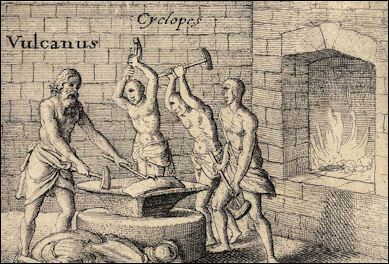 Many Roman gods were originally local gods or Greek gods that were woven into the general Roman scheme. Sometimes the transition from Greek to Roman god was simply a matter of changing the name. Other times they went through a more complex metamorphosis.
Many Roman gods were originally local gods or Greek gods that were woven into the general Roman scheme. Sometimes the transition from Greek to Roman god was simply a matter of changing the name. Other times they went through a more complex metamorphosis.
Some gods were highly regarded in some city-states and ignored in others. And some evolved from spirits. Janus was originally a spirit of the door that represented looking both ways and Venus was originally a sexless garden spirit that was united with Aphrodite to form the great goddess of love. Mars was the first great Roman god.
Household gods were important. Many houses had a lararium, a household shrine dedicated the worship of Lares and Penates, household spirits The Romans also worshiped spirits called Numina that didn't have any shape or form. Each family had its own god, Lar, who protected the house and food supply. These gods tended to be worshiped at home not in temples. Some groups and professions had their own gods and spirits. Sylvanus, for example, was a spirit that helped plowmen and woodcutters.
Gods unique to Roman mythology included: Saturn (god of agriculture); Janus (god of beginnings) was the source of the name January (He was a Numina); Fortuna (goddess of fortune); Terminus (the god of boundaries and endings); Maia (goddess of spring); and Quirinus (the defied Romulus, a war God)
See Separate Article: ANCIENT ROMAN GODS europe.factsanddetails.com
State Religion and Emperor Worship in Ancient Rome
According to Listverse: “While it is well known that the Romans worshipped many gods, there was, in fact, an official state god. This god was named Sol Invictus (the unconquered sun) and was created by the emperor Aurelian in 274 AD and continued, overshadowing other cults in importance, until the abolition of paganism under Theodosius I (on February 27, 390). The Romans held a festival on December 25 of Dies Natalis Solis Invicti, “the birthday of the unconquered sun.” December 25 was the date after the winter solstice, with the first detectable lengthening of daylight hours. There was also a festival on December 19. Though many Oriental cults were practiced informally among the Roman legions from the mid-second century, only that of Sol Invictus was officially accepted and prescribed for the army. Emperors up to Constantine I portrayed Sol Invictus on their official coinage and Constantine decreed (March 7, 321) dies Solis — day of the sun, “Sunday” — as the Roman day of rest. [Source: Listverse, October 16, 2009]
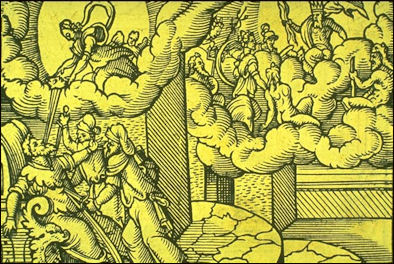
Caesar's deification In the wake of the Republic's collapse, state religion had adapted to support the new regime of the emperors. Augustus, the first Roman emperor, justified the novelty of one-man rule with a vast program of religious revivalism and reform. Public vows formerly made for the security of the republic now were directed at the well-being of the emperor. So-called "emperor worship" expanded on a grand scale the traditional Roman veneration of the ancestral dead and of the Genius, the divine tutelary of every individual. The Imperial cult became one of the major ways in which Rome advertised its presence in the provinces and cultivated shared cultural identity and loyalty throughout the Empire. Rejection of the state religion was tantamount to treason. This was the context for Rome's conflict with Christianity, which Romans variously regarded as a form of atheism and novel superstitio. Ultimately, Roman polytheism was brought to an end with the adoption of Christianity as the official religion of the empire. [Source: Wikipedia
Emperor worship was a key part of Rome state religion. Generally referred to as the imperial cult, it regarded emperors and members of their families as gods. Starting with Caesar and Augustus emperors that considered themselves gods ruled the Roman Empire. The Roman emperors seemed to believe in their divinity and they demanded that their subjects worship them. Marcellus was honored with a festival. Flaminius was made a priest for three hundred years. Ephesus had a shrine for Serilius Isauricus. Antony and Cleopatra referred to themselves as Dionysus and Osiris and named their children Sun and Moon. Caligula and Nero demanded to be worshiped like gods in their lifetime. And Vespasian said on his deathbed "Oh dear, I'm afraid I'm becoming a God."
Dr Nigel Pollard of Swansea University wrote for the BBC: “On his death, Julius Caesar was officially recognised as a god, the Divine ('Divus') Julius, by the Roman state. And in 29 B.C. Caesar's adopted son, the first Roman emperor Augustus, allowed the culturally Greek cities of Asia Minor to set up temples to him. This was really the first manifestation of Roman emperor-worship. [Source: Dr Nigel Pollard of Swansea University, BBC, March 29, 2011]
See Separate Article: STATE RELIGION AND EMPEROR WORSHIP IN ANCIENT ROME europe.factsanddetails.com
Household Shrines and Family Worship in Ancient Rome

an altar
Harold Whetstone Johnston wrote in “The Private Life of the Romans”: “The pater familias was the household priest and in charge of the family worship; he was assisted by his wife and children. The Lar Familiaris was the protecting spirit of the household in town and country. In the country, too, the Lares were the guardian spirits of the fields and were worshiped at the crossroads (compita) by the owners and tenants of the lands that met there. In town, too, the Lares Compitales were worshiped at street-corner shrines in the various vici or precincts. For the single Lar of the Republican period we later find two. Pompeian household shrines show frequent examples of this. They are represented as boys dressed in belted tunics, stepping lightly as if in dance, a bowl in the right hand, a jug upraised in the left. In place of the old Penates, the protecting spirits of the store-closet, these shrines show images of such of the great gods as each family chose to honor in its private devotions. The Genius of the pater familias may be represented in such shrines as a man with the toga drawn over his head as for worship. Often, however, at Pompeii the Genius is represented by a serpent. In such shrines we find two, one bearded, for the Genius of the father, the other for the Iuno of the wife. Vesta was worshiped at the hearth as the spirit of the fire that was necessary for man’s existence. [Source: “The Private Life of the Romans” by Harold Whetstone Johnston, Revised by Mary Johnston, Scott, Foresman and Company (1903, 1932) forumromanum.org |+|]
“The shrine, originally in the atrium when that was the room where the household lived and worked, followed the hearth to the separate kitchen, though examples of shrines are found in the garden or peristyle and occasion ally in the atrium or other rooms. |+|
“The devout prayed and sacrificed every morning, but the usual time for the family devotions was the pause at the cena before the secunda mensa, when offerings to the household gods were made.The Kalends, Nones, and Ides were sacred to the Lares. On these days garlands were hung over the hearth, the Lares were crowned with garlands, and simple offerings were made. Incense and wine were usual offerings; a pig was sacrificed when possible. Horace has a pretty picture of the “rustic Phidyle” who crowns her little Lares with rosemary and myrtle, and offers incense, new grain, and a “greedy pig.” The family were also bound to keep up the rites in honor of the dead. All family occasions from birth to death were accompanied by the proper rites. Strong religious feeling clung to the family rites and country festivals even when the state religion had stiffened into formalism and many Romans were reaching after strange gods. |+|
“The gens or clan of which the family formed a part had its own rites. The maintenance of these sacra was considered necessary not merely for the clan itself, but for the welfare of the State, which might suffer from the god’s displeasure if the rites should be neglected.” |+|
Vestal Virgins, Roman Rituals and Sacrifices
Vesta was the spirit of the hearth. The Vestal Virgins that tended her shrine were hired between the ages of six and ten and worked until they were in their later thirties.
The six virgins who watched the eternal flame of Rome, which burned for more than a thousand years, were ordained at the age of seven and lived in pampered but secluded luxury. As long as they remained pure, they were among the most respected women in Rome. They could walk unaccompanied and had the power to pardon prisoners. If they lost they virginity, however they were buried alive with a burning candle and bread so they could stay alive long enough to contemplate their sins. Under Augustus they were rewarded with the best seats at gladiator contests, exclusive parties and feasts with sow’s bladder and thrushes.
Romans from the earliest times of their existence practiced a purifying ritual called Lupercalia. Priests sacrificed goats and a dog at the Lupercal, the cave where legend says Romulus and Remus were suckled, and their blood was smeared on two youths. Young women were whipped across their shoulders in the belief it bestowed fertility. The rite was performed in mid February at an altar near Lapis Niger, a sacred site paved with black stones near the Roman Forum until A.D. 494 when it was banned by the pope.
Romans held sacrifices in which a bull, a sheep and a pig were offered. There was even a word to describe it (“ suovetaurilia” ) which was made by combining the Roman words for the three animals. “Genius “ was the male form of family power and it was usually represented by the head of a snake.
Both the Greeks and Romans salted their sacrifice victims before their throats were cut. Roman senators vied among themselves to see who could get the most blood on their togas during the sacrifice of steer, thinking it would prevent death. A 1,500-year-old earthenware vase that was once thought show human dismemberment actually depicted an ancient bronze statue assembly line.
Temples in the Roman Forum
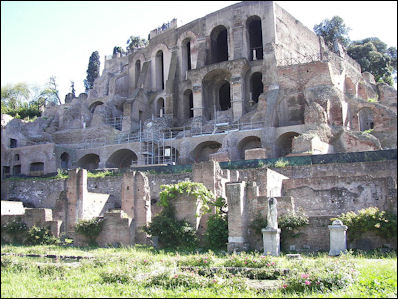
House of the Vestal Virgins in Rome The Lower Forum (below Palantine Hill on the Capitoline Hill side of the Forum) is the home of the Temple of Saturn, Temple of Castor and Pollex, the Arch of Augustus and the Temple of Deified Julius. Temple of Saturn (below Palantine Hill on the Capitoline Hill side of the Forum) is a structure with eight standing columns where wild orgies honoring the god Saturn were held.
The Temple of Castor and Pollex (next to the Basilica Julia) honors the Gemini twins, the equivalent of patron saints for armies and commanders. According legend they appeared at the Basin of Juturna at the temple and helped the Romans defeat the Etruscans at a pivotal battle in 496 B.C. The most noticeable part of the temple is a group of three connected columns. Down the road from the Temple of Castor and Pollex is the Arch of Augustus and the Temple of Deified Julius, which Augustus built to honor his father. Behind the Temple of Deified Julius is the Upper Forum.
Upper Forum (Colosseum-side entrance of the Forum) contains the House of Vestal Virgins, the Temple of Antonius and Fustina (near the Basilica of Maxentius. The House of Vestal Virgins (near Palantine Hill, next to the Temple of Castor and Pollex) is a sprawling 55-room complex with statues of virgin priestess. The statue whose name has been scratched is believed to belong to a virgin who converted to Christianity. The Temple of the Vestal Virgins is a restored circular buildings where vestal virgins performed rituals and tended Rome's eternal flame for more than a thousand years. Across the square fromm the temple is the Regia, where Rome's highest priest had his office.
The Temple of Antonius and Fustina (left of the Basilica of Maxentius) contains a firm foundation and well-preserved ceiling lattice work. Nearby is an ancient necropolis with graves that date back to the 8th century and an ancient drainage sewer that is still in use. The Temple of Romulus contains its original A.D. 4th century bronze doors, which still have a working lock.
Roman Mystery Cults
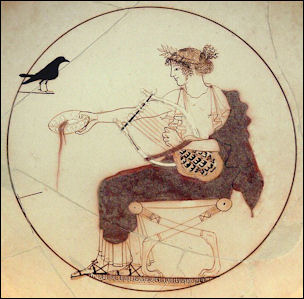
Libation by Apollo of a black bird There were hundreds of local gods and hundreds of cults, many devoted to specific gods. Many of the cults, were very secretive and had special initiation rituals with sacred tales, symbols, formulas and special rituals oriented towards specific gods. These are often described as mystery cults. Fertility cults and goddesses were often associated with the moon because its phases coincided the menstruation cycles of women and it was thought the moon had power over women.
In a review of “Mystery Cults in Ancient World” by Hugh Bowden, Mary Beard wrote in the Times of London, “For modern scholars, it has always been a frustrating task to discover the secret of these ancient mystery cults (“mystery” from the Greek mysterion, which has a range of meaning, from “Eleusinian ritual” to “secret knowledge” in a wider sense). What was it that the initiates of Dionysus or the “Great Mother” knew that the uninitiated did not? In his refreshing new survey,Mystery Cults in Ancient World, Hugh Bowden suggests that we have perhaps been worrying unnecessarily about that question. In fact, we don’t have to imagine the ancients were so much better keepers of secrets than we are, for no secret knowledge, as such, was transmitted at all. To be sure, there was a whole range of objects involved in these cults that outsiders could not see, and words that they were not allowed to hear. (In the cult at Eleusis, from descriptions of the public procession to the sanctuary, we can judge that the cult objects were small — at least small enough comfortably to be carried in containers by the priestesses.) But that is quite different from thinking that some particular piece of secret doctrine was revealed to the faithful at their initiation.
Mystery cults dedicated to Bachus were popular. Cults for Isis and Osiris and Mithras were popular with traders and soldiers. Initiates to cults honoring Cybele in Asia Minor were baptized in bull blood, which some thought ensured eternal life. Once accepted into the cult devotees were expected to castrate themselves as offering of their fertility in exchange for the fertility of the world. ["World Religions" edited by Geoffrey Parrinder, Facts on File Publications, New York]
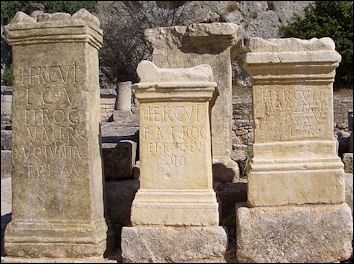
Altars for Hercules Roman initiation ceremonies depicted in a painting at the Villa of Mysteries in Pompeii, showed devotees who read liturgy, made offerings, symbolically suckled a goat, unveiled the mystic phallus, whipped themselves (symbolic of ritual death), danced to resurrection and prepared for holy marriage.
Cambridge classics professor Mary Beard wrote in the Times of London, “Livy includes in his history of Rome a lurid tale of the cult of Bacchus, which stresses debauchery, murder and a clever trick with sulphurous torches, which stayed alight even when plunged into the waters of the Tiber. Early Christian writers found these initiatory cults a predictably easy target. Clement of Alexandria, for example, at the end of the second or beginning of the third century AD, tried to forge an etymological link between the ritual cry of the Bacchic worshippers (“euan, euoi”) and the Judaeo-Christian figure of Eve — helped by a reputed fondness of the Bacchists for snakes. Clement’s idea was that they were actually worshipping the originator of human sin. [Source: Mary Beard, Times of London, June 2010]
How true some of the descriptions of cult activities were is a matter of debate. In a review of “Mystery Cults in the Ancient World” by Hugh Bowden (Thames and Hudson, 2010), Beard wrote that Bowden “takes many scholars to task (myself included) for assuming that the cult of the Great Mother in Rome, based on the Palatine Hill, just next to the Roman imperial palace, was served by ecstatic eunuch priests who castrated themselves with a piece of flint. Some of us had already been a little more circumspect about this than Bowden allows: you only have to read accounts of pre-modern full castration (for the Great Mother was supposed to demand the removal of both penis and testicles) to recognize that few priests could have survived any such procedure. But he shows that, feasible or not, the practice is anyway much less clearly attested in Roman literature than we like to think.
“More often than not, in fact, the details of these cults may not be quite as they seem,” Beard wrote. Bowden “cites an intriguing second-century AD inscription from just outside Rome, listing the members of a Bacchic troupe (or thiasos), under a priestess called Agripinilla. It is anyone’s guess whether we see here a group of respectable Roman men and women really imitating the mad Bacchants of Euripides’ play, and taking to the mountains in religious fervour — or whether this was the ancient equivalent of modern morris dancing (that is to say the Roman equivalent group of bank managers on their days off pretending to be lusty medieval rustics). My hunch, as Bowden almost suggests, is the latter.
This overlap between civic and initiatory religion comes out particularly vividly in a series of inscriptions commemorating leading pagan aristocrats of the late Roman Empire, which proudly list all their religious offices — initiation into mystery cults next to official state priesthoods. These were men who boasted of holding the traditional offices of augur or pontifex, as well as of being initiated into the cult of Mithras or Egyptian Isis. Bowden rightly focuses on these at the end of his book and argues against a common view that they reflect a new form of aggressive pagan religiosity, developed in response to the rise of Christianity, or that they are part of a pagan “revival” in a Christian context. Much more likely they show — albeit under the magnifying glass of late imperial Rome (where everything appears larger than life) — just how closely different forms and styles of cult, “mystery” or not, had always gone hand in hand. However secretive they might have been about what went on in their ceremonies, however uncertain or elusive the “message” of the cults might have been amid all that sound and light — initiation in a variety of different cults was something that these late antique aristocrats were happy to parade.
Book: "Mystery Cults in the Ancient World” by Hugh Bowden (Thames and Hudson, 2010)
Roman Views on the Afterlife
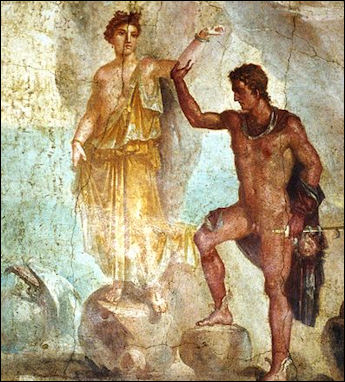
Pompeii fresco of Perseus and Andromeda Some Romans believed the that Milky Way was the stairway to heaven and that each star represented a departed soul. Ovid wrote how Venus swept down to the Senate and took the soul of Caesar from his assassinated body and the two of them formed a comet as they flew through the sky. Every person on earth, the famous and not so famous, was supposed have his or her own star, and our expression "to thank you lucky star" comes from that belief." ["The Creators" by Daniel Boorstin]
Following a custom established by the Etruscans, the first Romans, according to legend, dug a pit in the middle of the city that was said to have made it easier for the living to communicate with their dead ancestors in the Nether World. The first fruits of the harvest and clods of dirt from the homelands of new settlers was thrown in is an offering. During certain holidays the "door of the dead" (a stone at the bottom of the ditch was removed, allowing the spirits to roam the earth for a little while.
Image Sources: Wikimedia Commons, The Louvre, The British Museum
Text Sources: Internet Ancient History Sourcebook: Rome sourcebooks.fordham.edu ; Internet Ancient History Sourcebook: Late Antiquity sourcebooks.fordham.edu ; “Outlines of Roman History” by William C. Morey, Ph.D., D.C.L. New York, American Book Company (1901) ; “The Private Life of the Romans” by Harold Whetstone Johnston, Revised by Mary Johnston, Scott, Foresman and Company (1903, 1932); BBC Ancient Rome bbc.co.uk/history/ ; Project Gutenberg gutenberg.org ; Metropolitan Museum of Art, National Geographic, Smithsonian magazine, New York Times, Washington Post, Los Angeles Times, Live Science, Discover magazine, Archaeology magazine, Reuters, Associated Press, The Guardian, AFP, The New Yorker, Wikipedia, Encyclopædia Britannica, Encyclopedia.com and various other books, websites and publications.
Last updated October 2024
